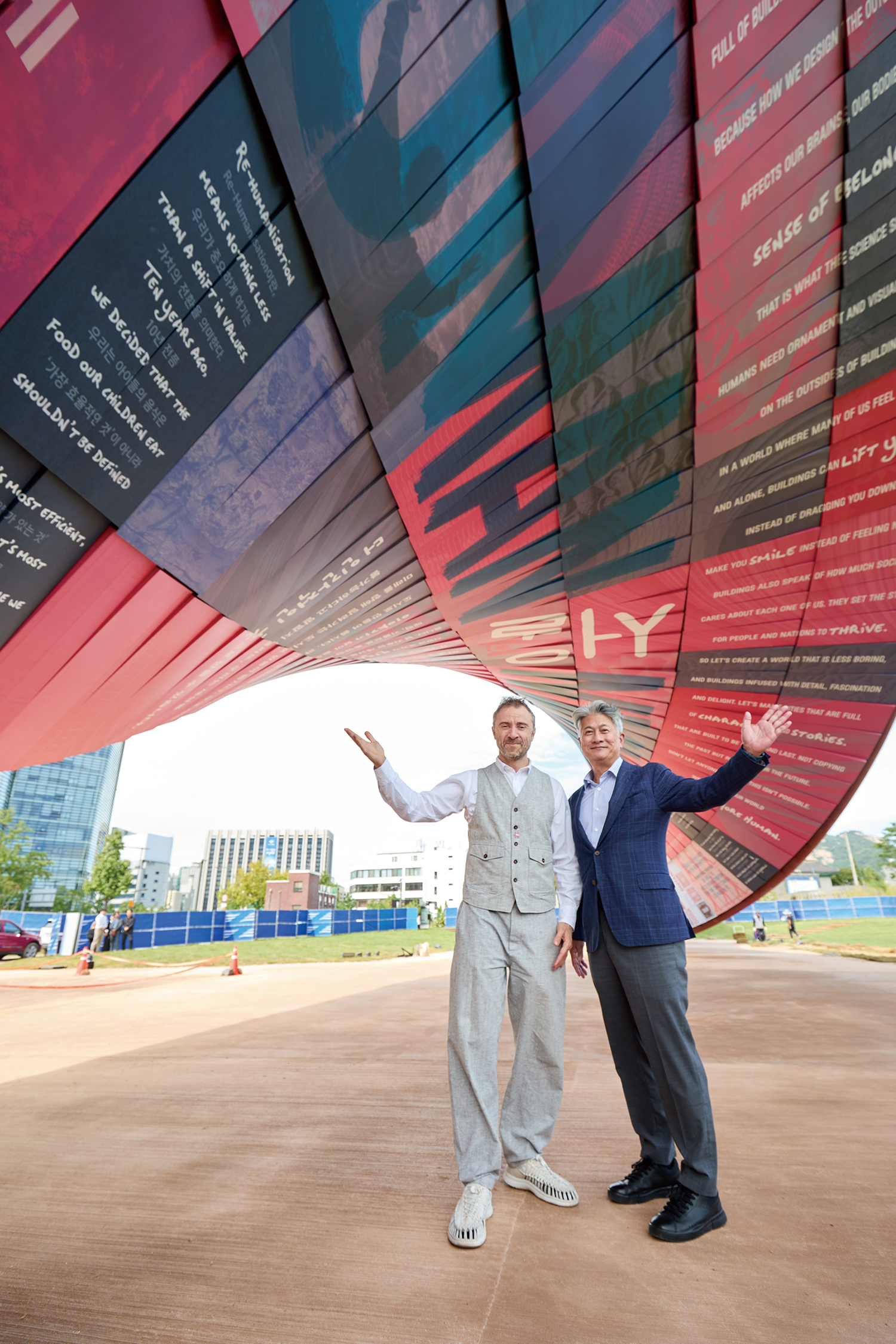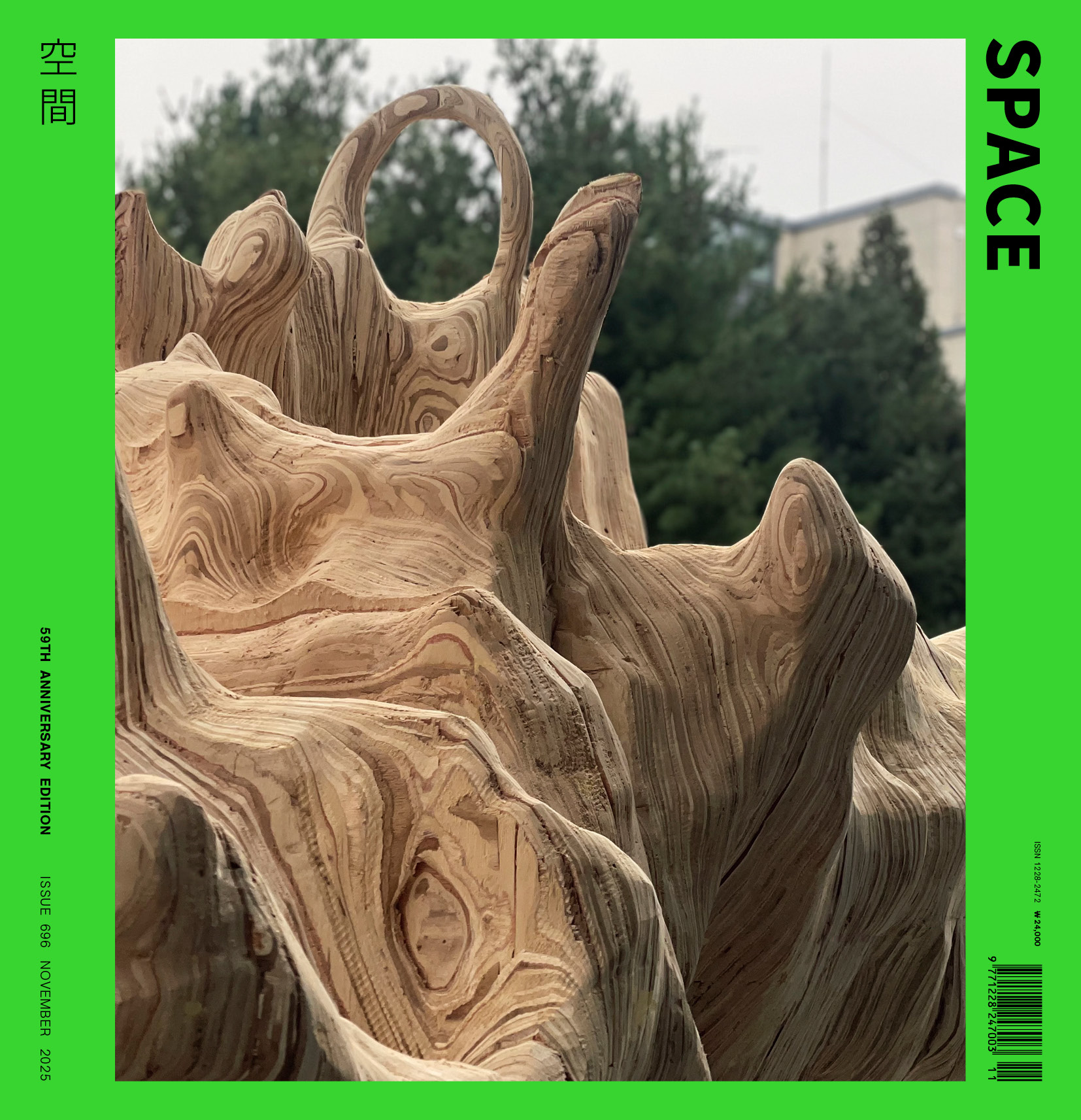SPACE November 2025 (No. 696)

(left) Thomas Heatherwick, (right) Chang Saewook, vice chairman of Dongkuk steel group. Image courtesy of Dongkuk steel group
A monumental pavilion by Thomas Heatherwick (general director of the 5th Seoul Biennale of Architecture and Urbanism), has been installed at the Songhyeon Green Plaza in Jongno-gu, Seoul. Standing 16m tall and stretching 90m in length, the massive structure, Humanise Wall, serves as a symbolic expression of the biennale’s theme, ‘Radically More Human: Architecture for People’. Composed of 1,428 uniquely printed steel panels, the gigantic wall features texts and graphics contributed by citizens, scientists, and designers from 38 different countries. Like a patchwork, every panel shows a different image or phrase which collectively forms a large-scale sculpture. The installation embodies Heatherwick’s core architectural philosophy; that people feel discomfort and alienation in monotonous and repetitive environments, and find comfort, meaning, and inspiration in dynamic environments filled with variety, texture, and patterning. Humanise Wall is thus not only a physical structure, but a shared global vision stitched together by human imagination.
Thomas Heatherwick revealed that he was inspired by jogakbo, traditional Korean patchwork. To go beyond this point of inspiration, he originally imagined an outdoor structure made of fabrics, however during the design development, he struggled with unfavorable environmental conditions. Under such circumstances, Chang Saewook (vice chairman of Dongkuk steel group), showed an interest in this challenging project and kindly proposed a solution: to use an different product, Luxteel, a premium printed steel product by Dongkuk CM. While reviewing the alternative product, Luxteel, Heatherwick sensed the multiple advantages of using Luxteel and he gladly accepted the proposal. Its primary benefits can be summarised into two ways – durability and a resistance to discolouration and corrosion over 30 years – and its environmental benefits are also persuasive, as an alternative to stone or wood, as well as offering unlimited expression in terms of colour and texture. This project went beyond simple sponsorship; it was a genuine collaboration between Dongkuk CM and Heatherwick Studio. When the installation work was completed, Heatherwick was impressed by the high quality of the final outcome and credited this achievement to the passion and artisanal commitment of the Luxteel team. He described Humanise Wall as a co-created work, a product of partnership. This collaboration extends far beyond material supply, it is an artwork aligning architectural vision with corporate technology.
In the Humanise Wall project, Luxteel not only demonstrated its durability but also proved the unique qualities of its technology by realising 1,428 distinct images in a single production process. Each panel was designed with irregular geometry and processed with precision to accommodate twists and curves. As a result, the ordinary steel panels have been elevated into artistic objects. The central twisted structure, in particular, functions as both an entrance and a roof, offering visitors a new architectural experience.
Humanise Wall illustrates the city’s face at the intersection of technology and art. From the distance, the wall, realised by Dongkuk CM’s advanced manufacturing techniques, is perceived as a static monumental landscape feature. But, upon closer view, countless stories of individuals begin to be revealed across these intricately woven panels. As visitors move through space, they encounter diverse architectural thoughts and urban philosophies and initiate a dialogue with the pavilion. At this point, the pavilion becomes more than a structure; it functions as a civic platform enabling an architectural conversation between the city and its people.
Through this project, Luxteel has established itself as a brand that successfully merges technology and emotion with its strengths in durability, versatility, and precision. In fact, Luxteel, which launched in 2011 under the slogan ‘Steel Meets Art’, has persistently challenged its perceived boundaries. ‘Luxteel Meets Heatherwick’ in 2025, is a project transforming an ordinary park into a shared exhibition ground. It should be understood as a part of their continuous efforts to challenge their technology. Luxteel aims to open new horizons where technology and art converge. Their pioneering journey to shape the future built environment will be on-going. Even after the end of the Seoul Biennale of Architecture and Urbanism, Humanise Wall will remain in central Seoul as an invitation linking citizens, the city, its architecture, and art.





